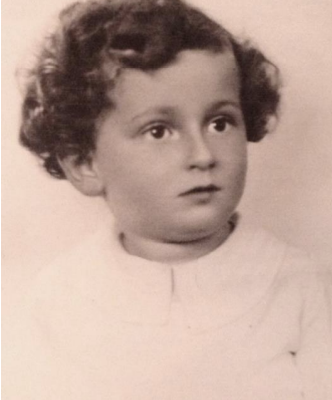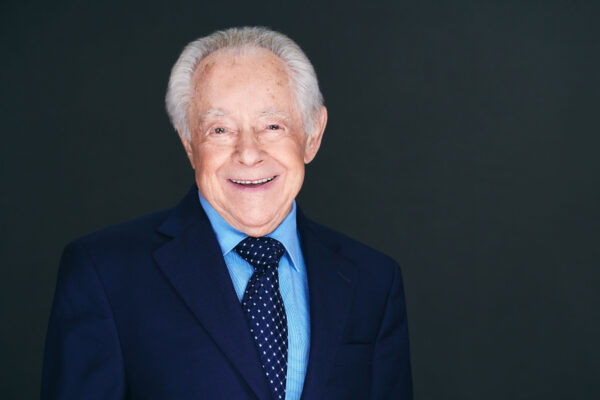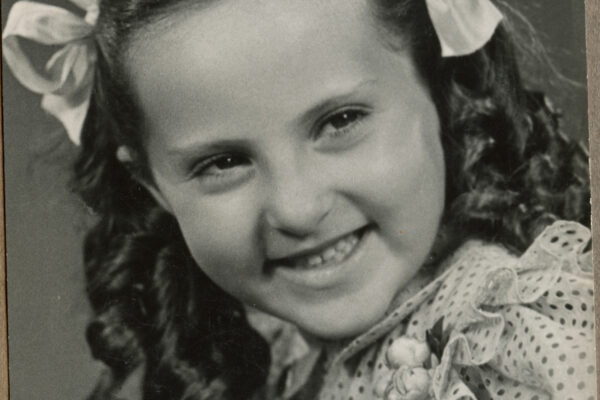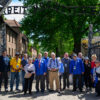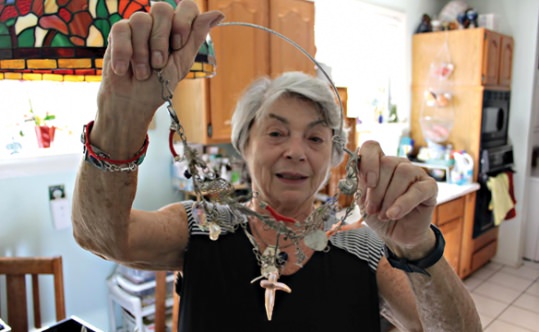
Eva Nathanson doesn’t feel the same guilt her parents did for having been spared an anonymous death at the hands of Nazis, when so many others perished.
Instead, she feels a compulsion to never spend a moment wasting time and to treat every minute of life as the miracle it is.
Sitting in her kitchen, just steps from Melrose Avenue in West Hollywood, she was surrounded by evidence of that attitude: art projects she led with her two grandchildren, ceramic sculpture of her own fashioning and a cabinet full of handmade Judaica, for starters.
Art, and especially the metalwork at which she excels, is more than just a way for Nathanson, 75, to keep busy. Instead, she called it “occupational therapy” that helps her deal not only with the everyday stressors of life in Los Angeles, but also the lasting impact of a childhood interrupted.
Her privileged upbringing ended unceremoniously one day toward the end of 1942 when a contingent of Hungary’s fascist enforcers barged into her grandfather’s living room in Budapest, and Nathanson, a toddler, went into hiding with her mother. Although almost everybody in her family was killed, including her father, a family friend helped Nathanson and her mother survive until the end of World War II.
In the years after the war, instead of processing the time she spent in perpetual fear cramped into small, dirty spaces, Nathanson instead encountered a repressive Stalinist society in Budapest where free expression was discouraged.
As a result, she feels as if the trauma of her earliest years never truly left her: Nathanson tries not to sit with her back to a door and experiences severe claustrophobia, a remnant of time spent in close quarters during the Holocaust years.
“I actually think that everything I do and have done somehow was affected by the first primitive feelings I must have had,” she said. “Especially since after the Holocaust in Hungary, there was no therapist you could go to.”
Although she had long found therapy to be helpful, she still searched for “something to bring out my other energy.” In the freedom and catharsis of sculpture and painting, ranging in theme and style, she found that something.
“It was getting rid of some of the emotions I wasn’t able to express,” she said. “And I found that it was very therapeutic.”
Where Nathanson moves beyond the realm of an inspired amateur is the jewelry she sits down to make two evenings a week. Fetching a box full of rings she crafted in various adult art classes, she picked through them one by one. The styles were as diverse as the methods she uses, but one of her favorites involves encasing a small object in a mold and then burning away the object and replacing it with silver. The box was full of silver molded into the shapes of figurines, flowers, seashells and even succulents she picked from her garden.
“The teachers, they always joke about the fact that there’s nothing sacred to me,” she said, laughing. “I’ll burn anything.”
Nowadays, Nathanson wields serious tools that could easily visit injury on even a much younger person, and although she feels comfortable with them, she nonetheless prefers the controlled environment of a classroom. “It would be very difficult to get insurance when you have boiling metal in the house,” she explained.
She’s come a long way since the younger of her two children was born 50 years ago. Back then, Nathanson — who has a master’s degree in business administration and spent 40 years as a hospital administrator, but took time off when her children were young — found herself isolated and somewhat bored after moving with her small family to the San Fernando Valley after years of living in West Hollywood.
“All the neighbor women were watching television and drinking coffee and gossiping, and that just wasn’t me,” she said. “So I decided I needed to do something for myself.”
Artistic sensibilities ran in her family: Her mother was able to sell needlework for food while in hiding during World War II, and her stepfather’s masterful carpentry made him enough of an asset to the Hungarian communist authorities that they refrained from deporting him after the war, despite his outspoken dissent. (Some of his chairs and tables still sit in her home today.)
So Nathanson wasn’t breaking ranks when she enrolled herself in classes for painting, then sculpting, then ceramics. Soon, she moved on to silversmithing, not least, she said, because “schlepping big pieces of sculpture” was not an option for a mother raising two children in close quarters.
“About 35 years ago, I walked into a jewelry class and I said, ‘Teach me something,’ ” she said.
Nathanson now sells some of her jewelry — which she refers to as “wearable art” — on the crafts website Etsy (etsy.com).
“I do sell a little, but I’m not a good salesperson,” she said. “I can’t sell anything. I mean, if people want to buy it, I let them buy it.”
Although she’s sold some art, Nathanson said she was privileged never to have had to rely on her art to support herself. Now retired from her job at Cedars-Sinai Medical Center and a cancer center in the Valley, she keeps busy as an event coordinator for her Jewish Renewal congregation, B’nai Horin, and volunteering as a lecturer at the Los Angeles Museum of the Holocaust and at various theaters and playhouses in Los Angeles.
In spite of the odds against her even having survived the war, she said she’s grateful to have achieved all she did and doesn’t take anything for granted.
“I feel that I have to make sure that I repay the fact that I’m alive — that I do what I was put on the earth to do.”
Originally published HERE
